Welcome to our Gardening in Alaska blog! Discover expert tips and insights for thriving in Alaska’s unique climate. From selecting cold-hardy plants to mastering watering techniques, we’ll guide you through every step to create a beautiful, productive garden, even in the Land of the Midnight Sun. Happy gardening!
1. Climate and Micro climate of Alaska
Gardening in Alaska can be both challenging and rewarding due to the state’s diverse climate conditions. Here’s a detailed look at how the different climate zones in Alaska affect gardening and what strategies gardeners can use to thrive in these conditions.
Maritime Climate Zone
- Location: Southern coastal regions, including the Aleutian Islands, the southeastern panhandle, and areas like Anchorage, Juneau, and Sitka.
- Temperature: Mild with smaller seasonal variations. Summer temperatures range from 50°F to 70°F, and winter temperatures from 20°F to 40°F.
- Precipitation: High, especially in the southeastern panhandle where annual precipitation can reach up to 275 inches. Frequent rain and high humidity.
- Growing Season: Long growing season from late April to late September due to mild temperatures.
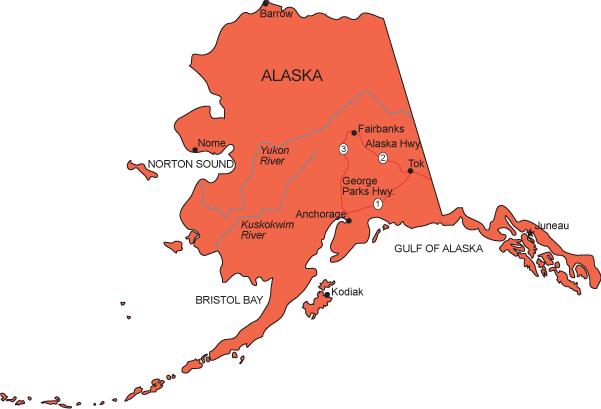
Subarctic Climate Zone
- Location: Central and interior regions, including Fairbanks and Denali National Park.
- Temperature: Large temperature variations between summer and winter. Summer temperatures can reach up to 90°F, while winter temperatures can drop to -40°F.
- Precipitation: Low to moderate, with dry summers and snowy winters.
- Growing Season: Short but intense, typically from late May to early September. Long daylight hours in summer.
Arctic Climate Zone
- Location: Northern regions, including the North Slope and Arctic Coastal Plain, such as Barrow (Utqiaġvik) and Prudhoe Bay.
- Temperature: Extremely cold winters and short, cool summers. Winter temperatures can plummet below -50°F, and summer temperatures rarely exceed 50°F.
- Precipitation: Low, mostly falling as snow. The region is considered a polar desert.
- Growing Season: Very short, typically from early June to late August. Continuous daylight during summer months.
2. Soil of Alaska
Alaska’s soil varies significantly across its vast landscape, influenced by factors such as climate, topography, and vegetation. Understanding these variations is crucial for successful gardening and agriculture in the state. Here’s an overview of the primary soil types found in Alaska and their implications for gardening:
Tundra Soils (Gelisols)
- Location: Arctic and northern regions, including the North Slope.
- Characteristics:
- Permafrost: These soils are underlain by permafrost, leading to very shallow active layers that thaw in the summer.
- Organic Matter: Often rich in organic matter due to slow decomposition rates.
- Drainage: Poorly drained due to permafrost and waterlogged conditions.
Boreal Forest Soils (Spodosols)
- Location: Interior and central regions, including areas around Fairbanks.
- Characteristics:
- Acidic: These soils are typically acidic due to the presence of coniferous vegetation.
- Nutrient-Poor: Often low in nutrients, especially nitrogen and phosphorus.
- Well-Drained: Generally well-drained but can vary based on local topography.
Volcanic Soils (Andisols)
- Location: Areas influenced by volcanic activity, such as the Aleutian Islands and parts of the southern coast.
- Characteristics:
- Fertile: Generally very fertile due to volcanic ash content.
- Good Water Retention: Excellent water-holding capacity.
- Nutrient-Rich: High in minerals and organic matter.
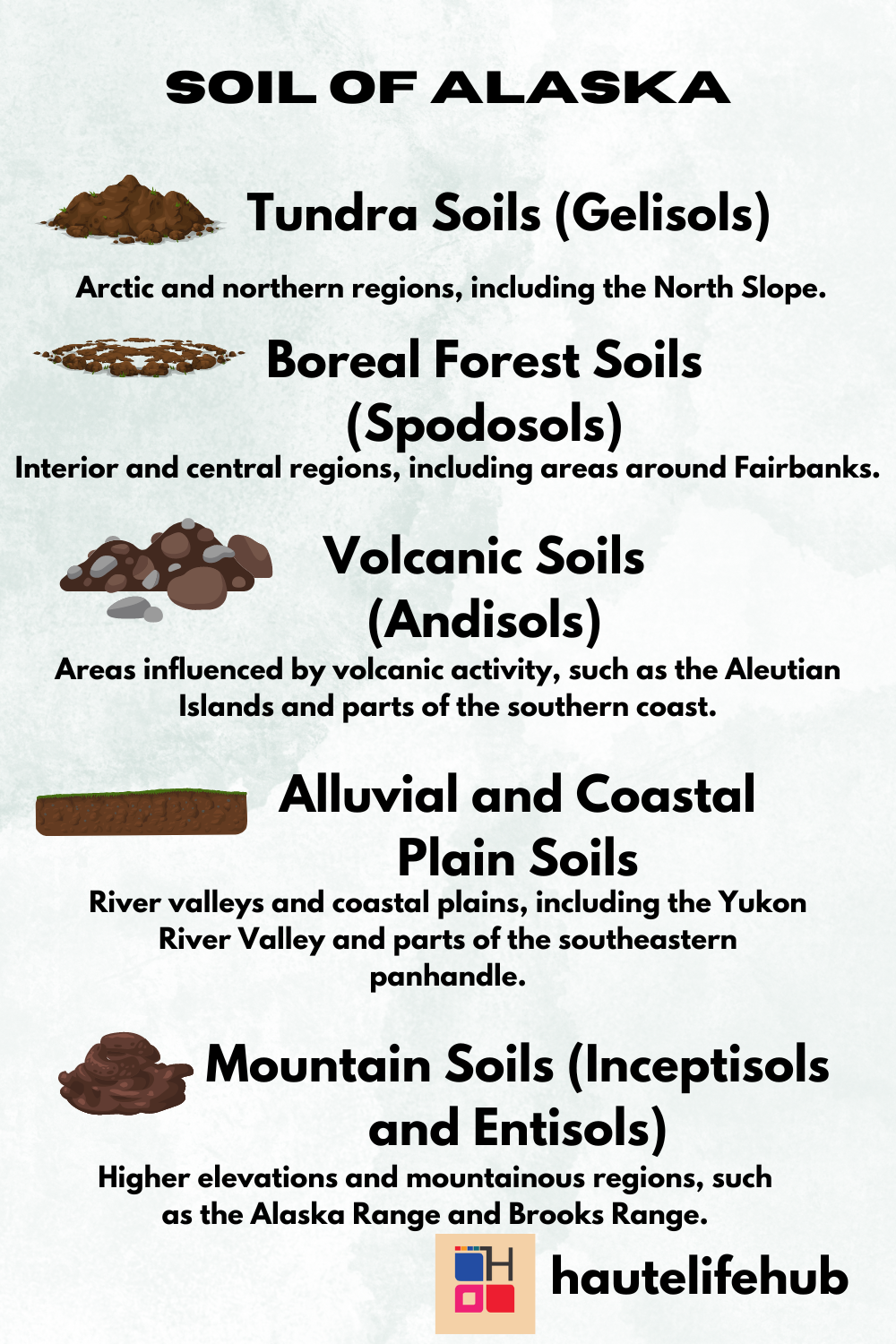
Alluvial and Coastal Plain Soils
- Location: River valleys and coastal plains, including the Yukon River Valley and parts of the southeastern panhandle.
- Characteristics:
- Variable Composition: Can range from sandy to silty and clayey.
- Fertile: Often nutrient-rich due to periodic flooding and sediment deposition.
- Drainage: Varies widely; some areas may be well-drained while others can be waterlogged.
Mountain Soils (Inceptisols and Entisols)
- Location: Higher elevations and mountainous regions, such as the Alaska Range and Brooks Range.
- Characteristics:
- Shallow and Rocky: Often shallow with a high content of rocks and gravel.
- Variable Fertility: Fertility can vary widely based on slope and parent material.
- Well-Drained: Generally well-drained due to slope.
3. Plant Selection in Alaska
Selecting plants for a garden in Alaska requires careful consideration of the unique climate and growing conditions. Alaska’s short growing season, cooler temperatures, and unique daylight patterns can be challenging, but many plants are well-suited to thrive in this environment. Here are some tips and plant recommendations:
Vegetables
- Root Vegetables: Carrots, radishes, beets, and turnips grow well in the cooler soil temperatures.
- Leafy Greens: Lettuce, spinach, kale, and Swiss chard thrive in the cooler weather and can tolerate some frost.
- Cabbage Family: Broccoli, cauliflower, and Brussels sprouts are cold-hardy and perform well.
- Potatoes: Well-suited for the Alaskan climate and soil.
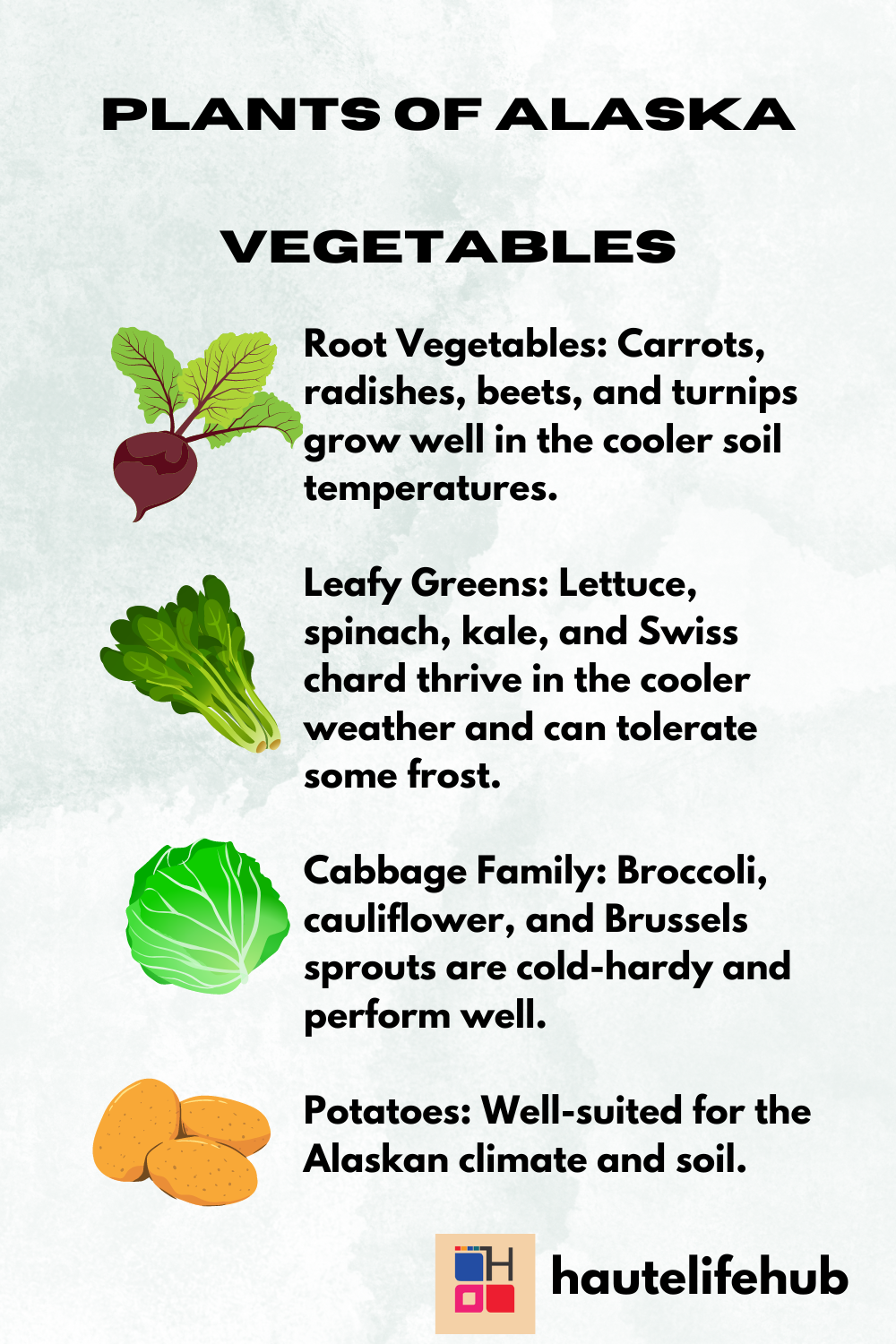
Fruits
- Berries: Blueberries, raspberries, strawberries, and currants are hardy and produce well.
- Rhubarb: A perennial that does very well in cooler climates.
- Apples and Crabapples: Select cold-hardy varieties specifically bred for northern climates.

Flowers and Ornamentals
- Perennials:
- Arctic Poppy: Thrives in cooler temperatures and full sun.
- Columbine: Hardy and attractive with a long blooming season.
- Lupine: Adds nitrogen to the soil and is beautiful and hardy.
- Annuals:
- Pansies: Can tolerate cold and even a light frost.
- Alyssum: Low-growing, fragrant, and cold-tolerant.
- Marigolds: Hardy and can deter pests.
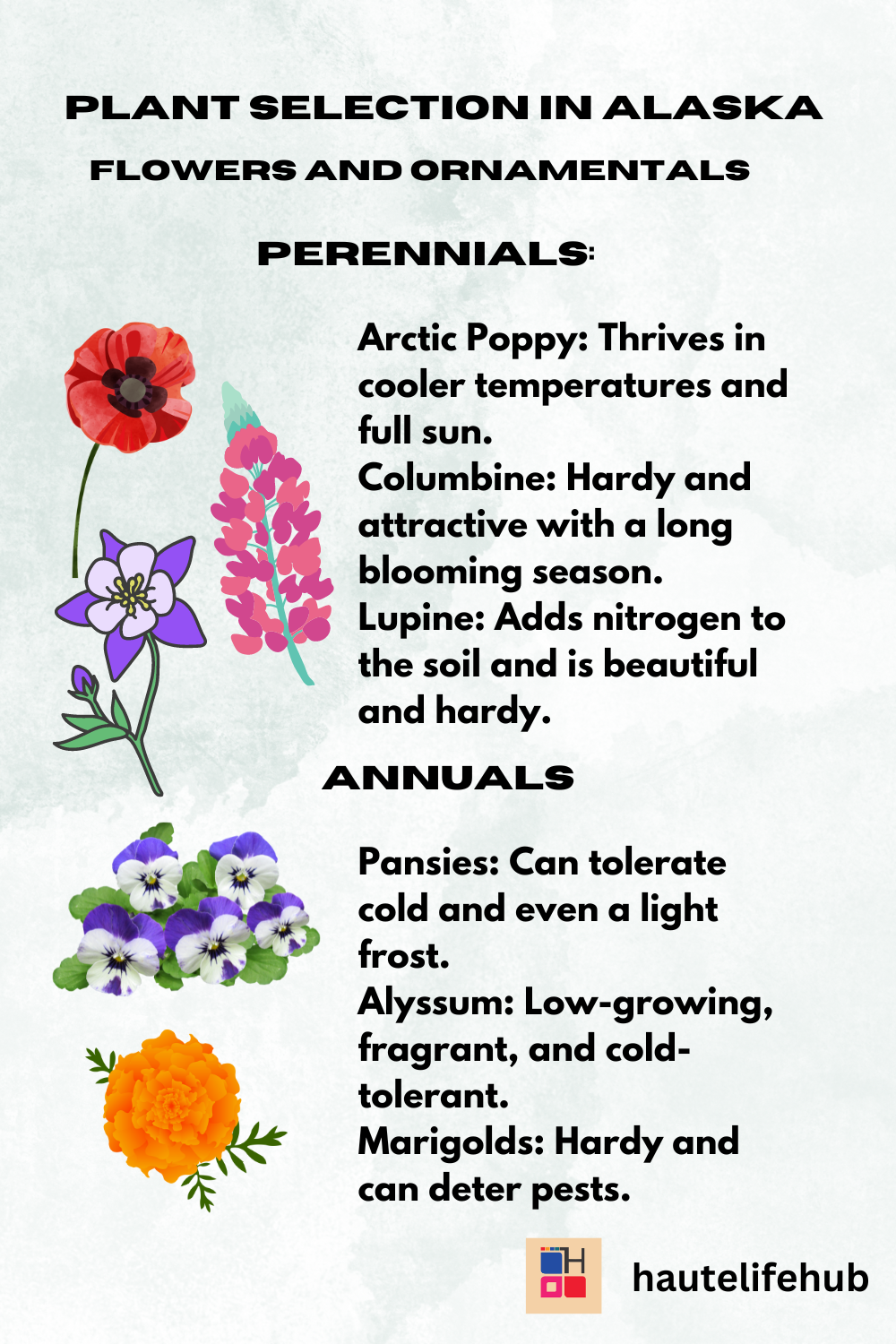
Trees and Shrubs
- Conifers:
- White Spruce: A native tree that’s very cold-hardy.
- Sitka Spruce: Another native that does well in coastal regions.
- Deciduous Trees and Shrubs:
- Birch: Adaptable and hardy, common in Alaskan landscapes.
- Willow: Hardy and moisture-tolerant.
- Dogwood: Shrubby varieties that can add color and are cold-hardy.
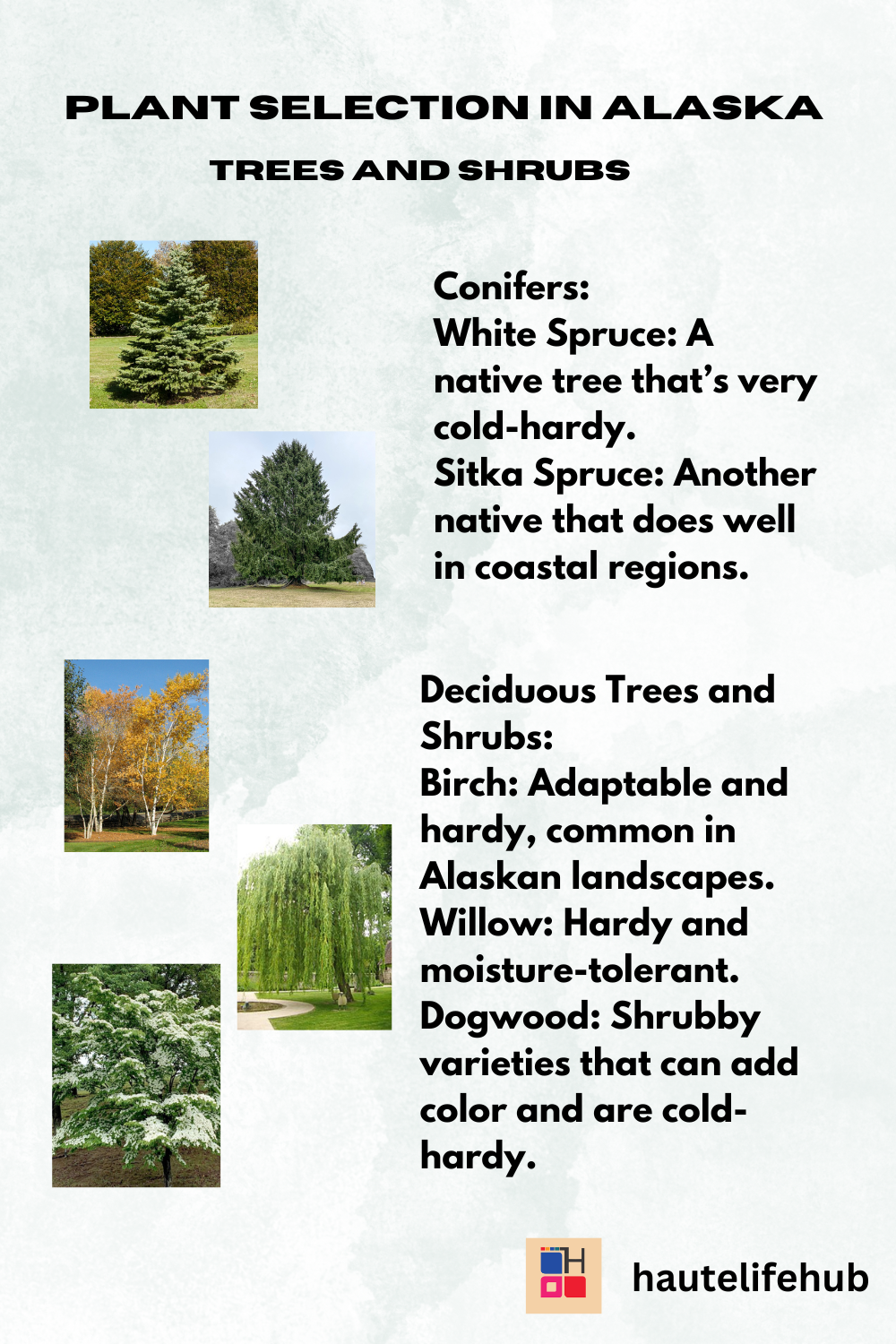
4. Watering in Alaska
Watering plants in Alaska requires attention to the unique climate conditions, including the short growing season, variable precipitation, and often cool temperatures. Here are some key points and strategies for effective watering:
Techniques for Efficient Watering
- Drip Irrigation and Soaker Hoses: These systems deliver water directly to the plant roots, minimizing water loss and ensuring efficient use.
- Mulching: Mulch helps retain soil moisture, reduce evaporation, and regulate soil temperature. Use organic mulch like straw, wood chips, or leaves.
- Rainwater Harvesting: Collecting rainwater can be an efficient and sustainable way to water your garden, particularly in regions with sufficient rainfall.
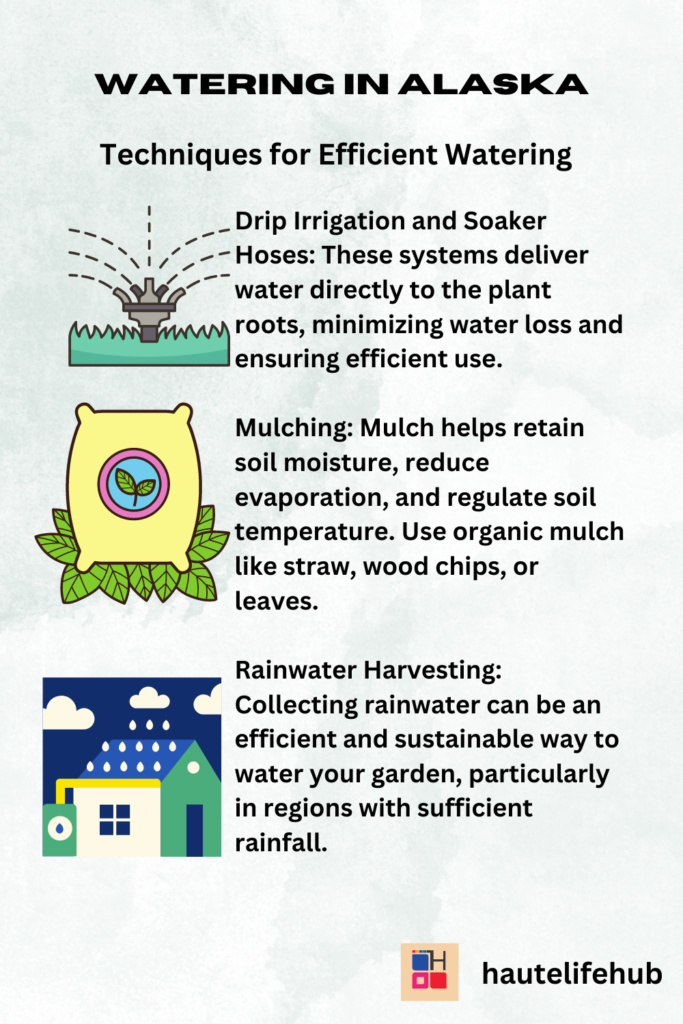
Special Considerations for Alaska
- Permafrost and Cold Soil: In areas with permafrost or very cold soil, raised beds and containers can help prevent root rot and improve drainage. Ensure adequate soil warmth before planting.
- Short Growing Season: Take advantage of the long daylight hours during the growing season. Adjust watering schedules to meet the accelerated growth rates of plants during this period.
- Rainfall Variability: Monitor local weather patterns and adjust watering practices accordingly. In regions with unpredictable rainfall, be prepared to supplement natural precipitation with manual watering.
- Wind Protection: In windy areas, use windbreaks or protective barriers to reduce evaporation and prevent plants from drying out.
5. Mulching in Alaska
Benefits of Mulching in Alaska
- Soil Temperature Regulation: Mulch helps insulate the soil, keeping it warmer in the cold and cooler during unexpected warm spells.
- Moisture Retention: Mulch reduces evaporation, ensuring consistent soil moisture levels, crucial in areas with irregular rainfall.
- Weed Suppression: A thick layer of mulch prevents weed growth, reducing competition for nutrients and water.
- Soil Improvement: Organic mulch decomposes over time, enriching the soil with nutrients and improving its structure.

Application Tips
- Timing: Apply mulch in late spring after the soil has warmed up, and reapply in the fall to protect against winter temperatures.
- Depth: Use 2-4 inches of organic mulch to provide adequate insulation and weed suppression without smothering plants.
- Placement: Keep mulch a few inches away from plant stems and tree trunks to prevent rot and rodent damage.
- Renewal: Refresh mulch annually to maintain its effectiveness and continue improving soil quality.
6. Pest Control in Alaska
Pest control in Alaska requires specific strategies due to the region’s unique climate and pest populations. While Alaska’s cold winters naturally limit some pests, gardeners still need to be vigilant about managing those that thrive during the short growing season. Here are some effective pest control methods for Alaskan gardens:
Common Garden Pests in Alaska
- Aphids: Small, sap-sucking insects that can damage a wide variety of plants.
- Cabbage Worms: Caterpillars that feed on cabbage, broccoli, and other related plants.
- Cutworms: Larvae that cut down seedlings at the soil level.
- Flea Beetles: Small, jumping beetles that chew small holes in leaves, particularly of young plants.
- Slugs and Snails: Mollusks that feed on a wide range of plants, especially in moist areas.
- Root Maggots: Larvae of flies that feed on the roots of plants like onions, radishes, and carrots.
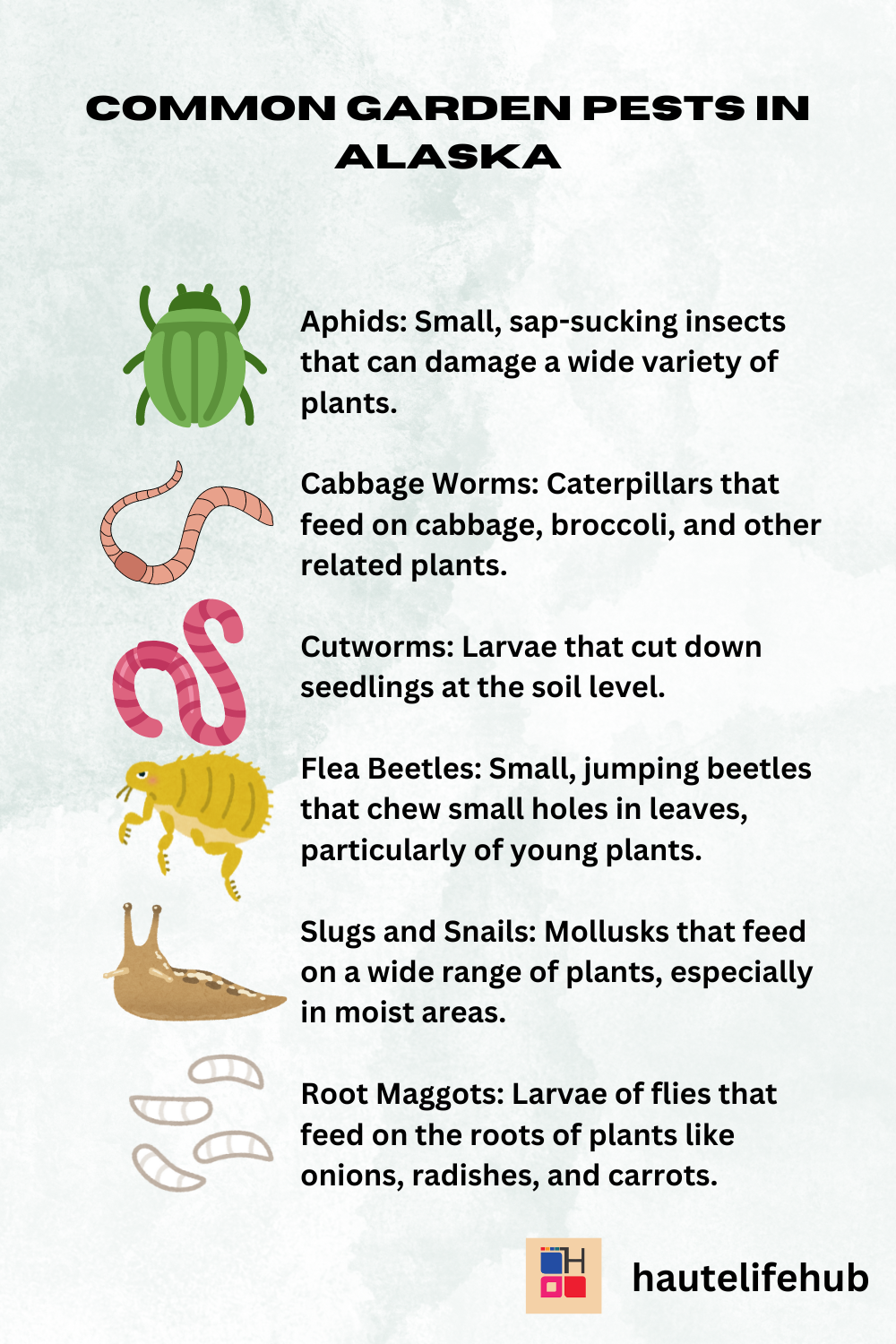
Organic Pest Control Methods
Physical Barriers:
- Row Covers: Lightweight fabric covers can protect plants from flying insects like cabbage worms and flea beetles.
- Collars: Placing collars around seedlings can prevent cutworms from reaching the stems.
- Slug Traps: Use beer traps or place boards around the garden to attract and collect slugs.
Handpicking:
- Regularly inspect plants and handpick pests such as slugs, snails, and larger insects. This is effective for small infestations.
Natural Predators:
- Encourage beneficial insects like ladybugs, lacewings, and predatory beetles by planting flowers and herbs that attract them.
- Birds can also help control pests; consider adding birdhouses or feeders to attract insect-eating birds.
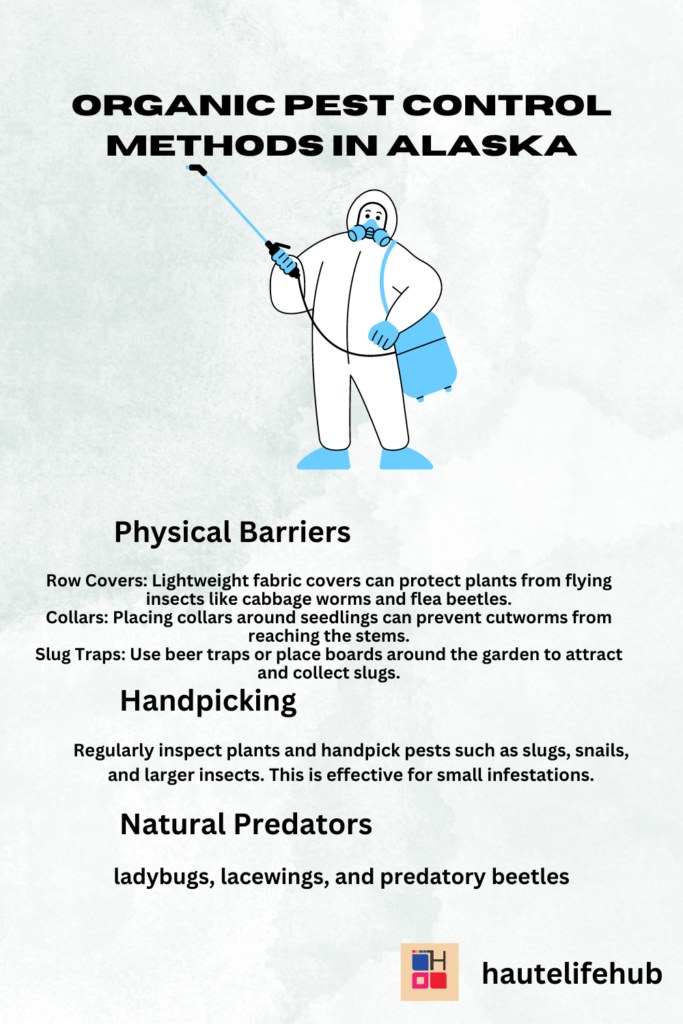
Biological Pest Control Methods
- Bacillus thuringiensis (Bt): A natural bacteria effective against caterpillars like cabbage worms.
- Nematodes: Beneficial nematodes can be applied to the soil to target root maggots and other soil-dwelling pests.
Companion Planting:
- Planting certain crops together can help repel pests. For example, marigolds can deter aphids and nematodes, while nasturtiums can attract aphids away from other plants.
Neem Oil and Insecticidal Soaps:
- Use neem oil or insecticidal soap sprays to control soft-bodied insects like aphids and mites. These are safe for use on edible plants and are environmentally friendly.
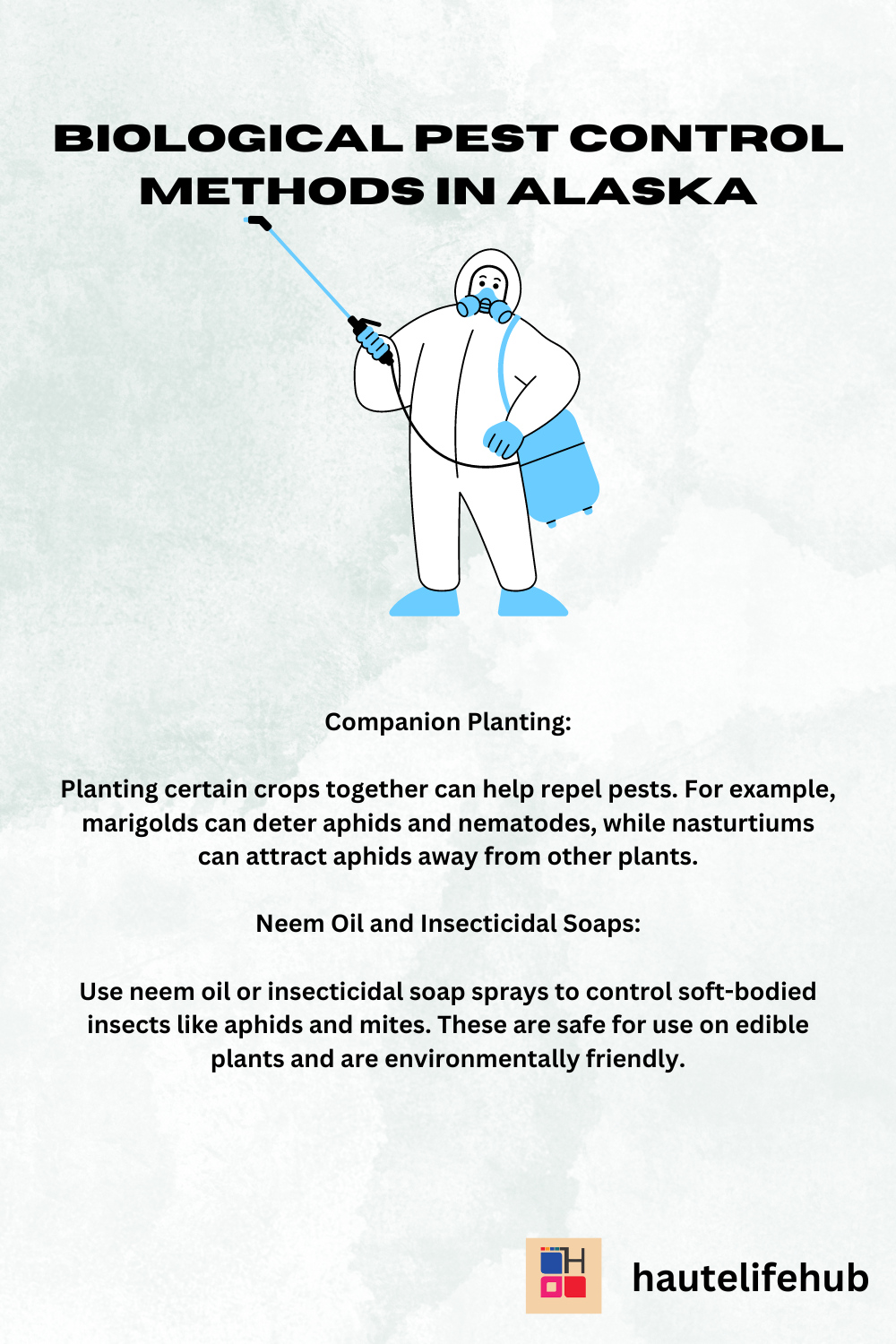
Preventative Measures
Healthy Soil: Maintain healthy soil through regular addition of compost and organic matter. Healthy plants are more resistant to pests and diseases.
Crop Rotation: Rotate crops each year to prevent the buildup of pests and diseases in the soil.
Cleanliness: Remove plant debris and weeds that can harbor pests and provide them with breeding grounds.
Proper Watering: Avoid overwatering, which can create favorable conditions for pests like slugs and snails. Water early in the day to allow foliage to dry.

Chemical Control
While organic methods are preferred, sometimes chemical controls may be necessary for severe infestations. If you choose to use chemical pesticides, select ones that are safe for food crops and follow the manufacturer’s instructions carefully. Always consider the impact on beneficial insects and the environment.
Monitoring and Maintenance
Regular Inspections:
- Check plants regularly for signs of pest damage or presence. Early detection can make management easier.
Record-Keeping:
- Keep a garden journal to track pest occurrences and control measures. This can help you anticipate and prevent future problems.
7. Community Resources in Alaska
In Alaska, community resources specifically tailored for gardening and agriculture play a crucial role in supporting residents who wish to grow their own food or engage in gardening activities. Here are some key community resources available across the state:
Cooperative Extension Services
- University of Alaska Fairbanks Cooperative Extension Service:
- Offers gardening workshops, educational resources, and publications tailored to Alaskan climates and growing conditions.
- Provides soil testing services and advice on soil amendments suitable for local gardens.
Community Gardens
Local Community Gardens: Many towns and cities in Alaska have community gardens where residents can rent plots to grow vegetables, herbs, and flowers. These gardens often provide a supportive environment for learning about gardening techniques and connecting with fellow gardeners.
Non-Profit Organizations
Alaska Botanical Garden: Provides educational programs, workshops, and demonstrations on gardening techniques suited for Alaska’s climate. Offers resources on native plants and sustainable gardening practices.
Alaska Master Gardener Program: Operated by the University of Alaska Cooperative Extension Service, this program trains and certifies Master Gardeners who volunteer to educate and assist the community with gardening questions and projects.
Native Plant Societies and Conservation Efforts
Native Plant Societies: Organizations such as the Alaska Native Plant Society focus on the conservation and cultivation of native plants. They provide resources, workshops, and plant sales featuring native species suitable for Alaskan gardens.
Government and Tribal Initiatives
Tribal Environmental Programs: Some Alaska Native tribes have environmental programs that support gardening initiatives, including community gardens and sustainable agriculture projects.
Educational Institutions
Alaska Pacific University: Offers courses and workshops on sustainable agriculture and gardening techniques appropriate for Alaska’s climate.
Accessing These Resources
Residents interested in utilizing these community resources for gardening can contact local Cooperative Extension offices, visit community gardens, attend farmers’ markets, and explore online resources provided by relevant organizations. Participation in workshops, joining gardening clubs, and volunteering with local initiatives are excellent ways to connect with the gardening community in Alaska and gain valuable knowledge and support.

